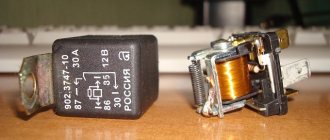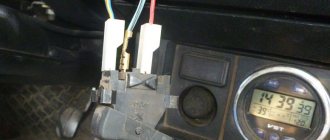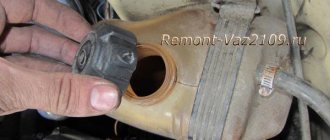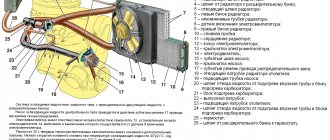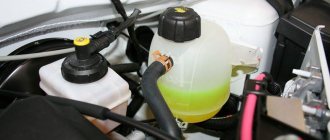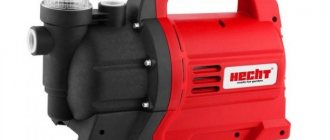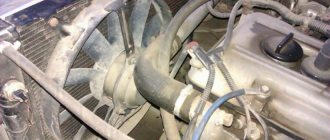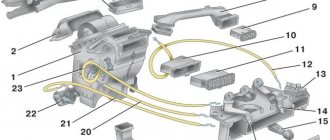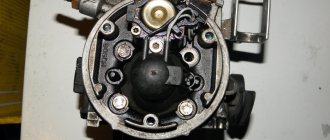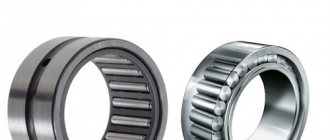Internal combustion engine cooling systems have been divided into two branches during their development: air cooling and liquid cooling. It is more correct to call a liquid cooling system hybrid, since the fan is used in both types of systems. The medium for dissipating excess heat in the process of removing it from a heated power plant is air. A cooling fan is a device that ensures stable and uniform heat transfer to the environment.
The hybrid cooling system has almost completely replaced the air cooling system in the design of production cars, so further we will talk exclusively about it. It is also worth noting that the function of the fan in both systems is similar. The cooling fan allows for forced and efficient airflow of the engine and radiator of the hybrid liquid cooling system.
We also recommend reading the article about the design of the thermostat for a liquid cooling system. From this article you will learn about the principles of operation of the device, its functions in the system, common faults of the element and methods for eliminating them.
The fan serves to better cool the engine and the fluid in the radiator. This effect is achieved by blowing the internal combustion engine and increasing the flow rate and total mass of air that passes through the cells and fins of the radiator. In most cases, the fan installation location is the space between the radiator and the power unit. The radiator fan itself is enclosed in a special casing.
Best Cooling Fan Manufacturers
There are several manufacturers whose fans cope well with the load. Each brand has its own advantages over its competitors, but the main feature of the presented fans is considered to be reliability compared to analogues.
SAT
Description of the design. Among manufacturers of elements for the cooling system, the SAT brand stands out for its large assortment of spare parts on the aftermarket. The Chinese fan is low cost and of average quality. The fan in a plastic case can be of several options. Different car models have their own series of radiator fans with different characteristics.
Kinds. Elements with hydromechanical and electric drive are produced. The electric drive is more in demand in the aftermarket.
Life time. The guaranteed operation period is 1 year, but with appropriate care and compliance with operating rules, the actual operation period reaches three years without repair.
Pros of the SAT
- Little noise.
- There are devices for various car models, including SUVs.
- Large assortment at a price lower than analogues.
- A budget option of average quality that can work for a long time without repair.
Cons of the SAT
- Marriage may occur.
- Works weaker than original fans.
Nissens
The Danish company Nissens is one of the most famous manufacturers of cooling systems. The fans are of proven quality.
All requirements of ISO 14001, TS 16949, ISO 9001 certificates are met.
The reliability of aftermarket parts, which are similar in characteristics to the originals, is noted.
Description of the design. What distinguishes the fan is its thickened casing and the use of durable materials that are resistant to corrosion and other types of damage.
Kinds. Among the types of fans produced, you can find all drive options. Electric is considered the most popular, but hydromechanical is also in demand. A separate series of spare parts with mechanical drive is intended for special equipment.
Life time. The warranty period for various fan options varies from 1 to 2 years. The duration of operation itself is not limited, that is, with careful use, the spare part can last more than 5 years.
Pros of Nissens
- An expanded line of fans and various types of electrically driven devices for popular car brands.
- Good quality and guaranteed reliability.
- There are no complaints about the operation of the device.
Cons of Nissens
- High price relative to competitors.
- A large number of fakes. It is necessary to immediately check the fan for logos, imprints and defects.
Behr Hella
The Behr Hella brand guarantees high-quality performance of fans for cooling systems in various car brands.
Description of the design. Aftermarket parts have earned a positive reputation for using quality materials that provide long service life.
Kinds. The range includes fans with a mechanical drive for special equipment, hydromechanical fans for SUVs, as well as standard fans with an electric drive.
Life time. The warranty is issued for two years, since aftermarket parts do not differ from the originals. The service life can exceed 10 years if all maintenance conditions are met.
Pros of Behr Hella
- Guaranteed quality from the leader in aftermarket cooling system parts.
- Long work.
- There are no problems associated with increased noise or defective operation.
- There are few differences from the original fans that are installed when assembling a car on an assembly line.
Cons of Behr Hella
- High cost relative to other manufacturers from the middle price segment.
- It is difficult to avoid counterfeits on the secondary market. Most often, they are distinguished by the absence of special brand marks and lower cost.
LUZAR
Luzar has a range of spare parts for the cooling systems of domestic and foreign cars. The difference between the fan will be compliance with GOST requirements, as well as an extended warranty period.
Description of the design. Spare parts are made from high-strength materials that are little subject to wear. They are supplied to factories from trusted foreign suppliers.
Kinds. The range includes fans with electric, hydromechanical and mechanical drives. The most expanded range is for models with electric drive.
Life time. The warranty is valid for 2 years, but due to the high-quality workmanship, which is close to native analogues, aftermarket parts can last up to 10 years without repair or replacement.
Pros of LUZAR
- Small number of defects, defects and fakes.
- Good quality at a price lower than foreign competitors.
- Expanded series for domestic and Asian cars, including hydromechanical ones for a number of powerful cars.
Cons of LUZAR
- Electrically driven fans have low performance due to a weak motor.
Common faults and diagnostics
Remember that diagnosing a malfunction of a cooling system fan should be done with extreme caution, as the rotating impeller can seriously injure your fingers or other parts of the body! It is not uncommon for a faulty fan to suddenly start moving!
Cooling system fans are installed both in front of the radiator and behind it, on the engine side. There is no established uniform standard regarding the installation location among designers. Many car owners also often wonder in which direction the fan blows. There is an opinion that it blows the radiator for better cooling of the coolant. It is worth remembering that the fan blows exclusively on the engine, regardless of its location. Installation in front of the radiator does not mean that only the radiator itself is blown. Changing the blowing direction is unacceptable.
Any electric motor or viscous coupling of different power and production technology, as well as the electronic unit or regulator designed for control, cannot provide a 100% guarantee of protection against malfunctions. The problem is further aggravated by the fact that a failed fan of the cooling system of the power unit will immediately entail serious consequences in the form of engine overheating. Even control devices designed to promptly inform the driver at a critical moment fail. It is necessary to monitor the condition of the fan and its serviceability with enviable regularity. While driving, it is also worth taking another look at the temperature indicator on the instrument panel at the first opportunity.
Simpler systems with a thermal switch are easy to diagnose faults. As for modern cars, then it is very important to correctly determine not only the breakdown of the fan itself, but also to identify the failed element in a chain of several devices. At the very beginning of the diagnosis, you need to find the problem that caused the fan to stop working. Any of the sensors, the control unit or the electric motor itself can fail. You can easily diagnose the problem yourself by following the recommendations below.
Mechanical drive systems are diagnosed quickly. Just watch the fan, which should rotate constantly. If you see rotation and the impeller blades are intact, then look for the problem elsewhere. Engines with a viscous coupling overheat due to a faulty fan only if the clutch does not provide sufficient blocking of the impeller at high crankshaft speeds. The result is a low fan speed and airflow that does not correspond to the load on the motor. Clutch malfunction can be determined by analyzing the fan rotation speed at low and high speeds.
If your car has an electric cooling fan, then start by monitoring its operation. When the fan does not turn on due to obvious overheating, you can use the following method for diagnosing systems with a thermal switch:
- you need to disconnect the thermal switch connector, which is often screwed into the bottom of the radiator tank;
- Next you will need some wire. Using caution, we use the specified wire as a jumper, which must be used to close 2 sockets of the disconnected connector;
If the fan is forced to start after such an operation, then the malfunction of the thermal switch is quite obvious. A non-working fan will mean a malfunction in it or in other parts of the circuit. The design may also consist of a double temperature sensor. The check should be done in two stages, although the principle remains the same. At the very beginning, the first two contacts are closed, after which the fan should rotate at low speeds. Next, the second pair closes, after which the rotation speed should increase noticeably.
It also happens that the radiator cooling fan blows constantly, without visible pauses. Such symptoms are quite common. This may indicate a failure of the power sensor. The check should be carried out with the ignition on by further removing the corresponding connector from the sensor. If the fan does not turn off after this, then the shutdown regulator should be replaced. Additionally, you can check the fuse if problems with the performance of the cooling fan have not disappeared.
The main thing to remember is that, as in any other electrical circuit, it is worth diagnosing the malfunction of individual components using the method of elimination. The condition of the wiring, connectors and plugs will require no less attention. In some cases, the breakdown can be quickly eliminated by simply repairing the cable, which requires insulation, and by cleaning the contacts. Replacing the plug may be no less productive. If after all the diagnostic procedures the fan still does not work, then it needs to be dismantled and replaced.
The above methods cannot be recommended for those car owners who have a car with an electronic device for controlling the rotation speed of the cooling fan. An inexperienced driver can independently check only the serviceability of the fuse that is responsible for this section. Next, you need to contact a car service center for help.
Fan Drive Types
The fan consists of several parts, including the drive.
Fan location in the cooling system.
There are three types:
- Mechanical.
- Hydromechanical.
- Electric.
Mechanical drive
The mechanical drive option is considered costly for power due to the fact that the force for operation is taken from the crankshaft using a belt. This type of connection is considered obsolete and is used on older car models or special vehicles.
Hydromechanical drive
The hydromechanical drive is also considered ineffective for most modern cars. It is most widely used among SUVs and powerful cars. The operating principle is based on a viscous coupling, which is connected by a drive to the crankshaft.
Electric drive
An electric drive is the most common option for a cooling fan. It is installed on almost all modern cars. The difference is considered to be the complexity of the system and the presence of a large number of elements.
If there is an electric drive, it is connected to the vehicle’s electronic system and equipped with special sensors.
The only disadvantages will be the need to regularly check the settings and the effective operation of the control unit.
An important point is the tandem operation of the electric motor and control system. Electric drives in fans are most promising for passenger cars.
What is a car radiator fan
When the motor is running, it generates a lot of heat. The cylinder block itself of a classic internal combustion engine is designed in such a way that there is a cavity in its walls that is filled with coolant (cooling jacket). The cooling system includes a water pump that operates while the crankshaft rotates. It is connected to the crankshaft via a timing belt (read about it in detail separately ). This mechanism creates circulation of working fluid in the system, due to which it removes heat from the walls of the engine.
Hot antifreeze or antifreeze goes from the engine to the radiator. This element appears to be in the form of a heat exchanger with a large number of thin tubes and cooling fins to increase the contact surface. More details about the design, types and operating principles of radiators are described here .
The radiator is only useful when the car is moving. At this time, a counter flow of cool air blows over the surface of the radiator, resulting in heat exchange. Of course, its effectiveness depends on the ambient temperature, but while driving this flow is still much cooler than the engine coolant.
The principle of cooling operation is at the same time its disadvantage - maximum cooling is only possible when the car is moving (cold air must penetrate the heat exchanger). In urban environments, it is impossible to ensure a constant process due to traffic lights and frequent traffic jams in megacities. The only solution to this problem is to create forced air injection onto the surface of the radiator. The fan performs exactly this function.
When the engine temperature rises, sensors are triggered and the heat exchanger is blown. More precisely, the blades are configured so that the air flow is not supplied against its movement, but is sucked in. Thanks to this, the device is able to increase the radiator airflow even while the car is moving, and when the vehicle is stationary, fresh air enters the engine compartment, rather than using the hot environment near the engine.
In older cars, the fan was rigidly mounted on the crankshaft, so it had a permanent drive. If in summer such a process only benefits the power unit, then in winter excessive cooling of the engine is not beneficial. This feature of the constant operation of the device prompted engineers to develop an analogue that would work only when it was required.
How does an electric fan work?
An electrically driven fan consists of a system-controlled unit and an electric motor. Sensors are installed to determine the temperature regime on the basis of which air cooling will operate.
The standard system has the following components:
- Control block.
- Temperature sensor.
- Mass air flow sensor or pressure sensor.
- Control relay for switching on and off.
- Sensor for counting crankshaft revolutions.
Operation begins from the control unit receiving signals from sensors, their analysis and the subsequent command sent to the regulator. This could be a relay or a special control unit that is installed in new car models.
The block differs from a relay in its more accurate operation and increased level of efficiency. Another distinctive feature is the registration of the direction of the air flow by fixing the angle of the fan position, as well as determining the moment at which the fan turns off.
How to repair an engine cooling fan yourself?
Before removing the fan, you need to disconnect the ground wire from the battery, as well as all wires going to the fan. After this, you can unscrew the fan mounting bolts and remove it.
To prevent breakdowns and improve the quality of cooling, you need to periodically clean the fan from various contaminants using a brush.
Sometimes it happens that the culprit of a fan malfunction is ordinary dirt. To check this, you only need to bend the engine casing and assess the condition of all equipment. In most cases, brushes will need to be replaced, as they often fail due to excessive contamination and subsequent rapid wear.
Quite often, the breakdown consists only of poor contact of the wires. This occurs due to severe oxidation of the contacts (in the connecting plugs), which have never been cleaned during the entire period of operation of the car. That is why, before changing anything, you need to carefully check the condition of the wires, and if necessary, replace or clean them.
At the next stage, the performance of the rotor, or rather its windings, is checked. If she's okay, then you can breathe a sigh of relief. If a break or short circuit occurs, you will have to inspect each turn to identify the malfunction. But before this, you need to thoroughly clean everything from dirt using a metal brush and a rag with a solvent, which in no case should contain chemically aggressive components.
When the engine overheats and the fan does not turn on, this indicates a breakdown of the electric motor. This part cannot be disassembled and subsequently repaired, so the electric motor only needs to be replaced.
The process of purging the radiator and replacing the fan, in relation to a Ford Focus car, is shown in the video.
Which radiator cooling fan to buy
There are several rules for choosing a cooling fan. First you need to find out the cause of the malfunction of the old fan. On the secondary spare parts market you can buy individual elements for almost any version of the cooling device. An example would be the purchase of an electric motor, an impeller, and a separate relay.
This option is possible with a new fan that is not worn out. When it wears out, a full replacement is required.
When replacing you must:
- The selection of a fan is carried out according to the VIN code, that is, an analog or original spare part is purchased that fits all parameters.
- There are many different parts on the market in every price segment. You should not pay attention to very cheap spare parts, as they may be defective.
- The choice of manufacturer is made based on the recommendations of car owners and service center specialists. Reviews often show all the advantages and disadvantages of each brand.
It is important that all fasteners match and that the fan is not modified for installation, as otherwise errors and defects in operation may occur.
The fan must also be suitable in terms of power and other parameters. Be sure to take into account the car make, model and engine parameters.
Among the popular brands of air cooling fans are companies that supply spare parts to the aftermarket with a good price-quality ratio. Each type of fan has its own characteristics, as well as parameters that need to be taken into account when choosing.
How to find the cause of a fan failure?
A faulty engine cooling fan can cause the power unit to overheat, so you need to constantly monitor the fan's performance. If it breaks, it is necessary to find the cause of this problem as quickly as possible and eliminate it.
First of all, remove the plug connector from the temperature sensor. If it is single, then you can check its serviceability by manually shorting the terminals in the plug with a piece of wire. If the temperature sensor is double, then the red-white and red wires are closed first - the fan should rotate slowly. Then connect the black and red wires - the fan should rotate quickly. The fan should work in all cases, but if it doesn’t, it should be replaced.
When the fan is running, but only at high speed, the additional resistance needs to be replaced.
If all these checks are unsuccessful, then you should check the fuse. The fan connector on the red-white or red-black wire is supplied with power from the battery terminal with a positive charge, and the brown wire is supplied with a negative wire from the battery. If the fan does not work, it means it is faulty; otherwise, you need to carefully inspect all the plugs and connectors on the wires going from the temperature sensor to the fan.
When the engine cooling fan does not turn off but runs constantly, this may indicate a failure of the fan switch sensor. Its serviceability can be checked as follows: turn on the ignition and remove the wire tip from the sensor. The fan still does not turn off - the sensor is being replaced.
The video below shows how to check and replace the temperature sensor on VAZ cars.
In some cases, there is no need to completely change the device, since the damage may be minor and it will be much cheaper to repair it yourself.
